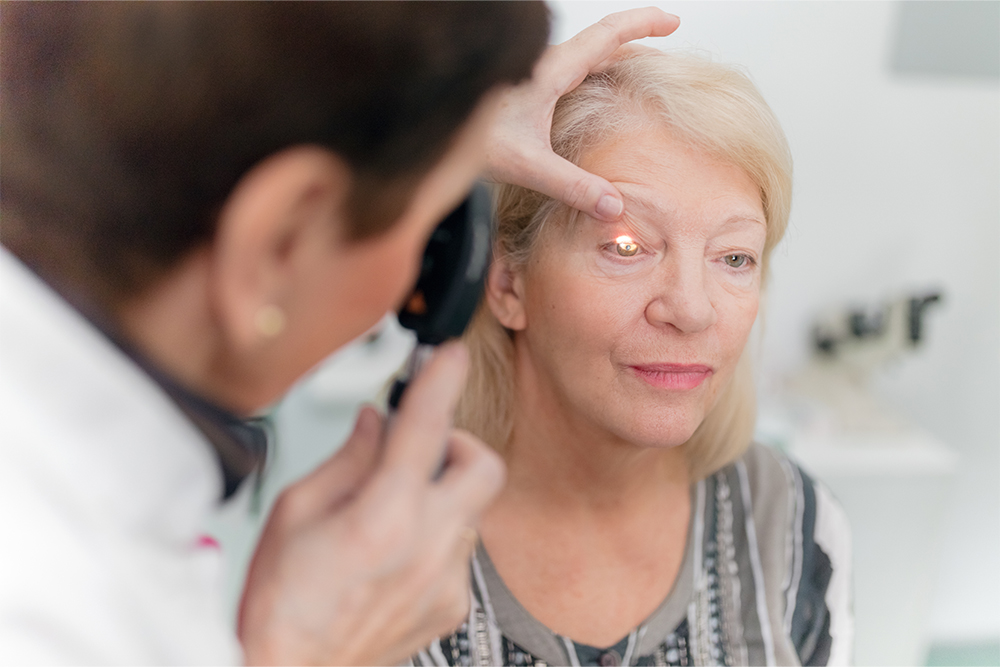January is Glaucoma Awareness Month: Signs & Symptoms to Watch For

January is National Glaucoma Awareness Month — a time to heighten public awareness of this disease that affects so many. As the leading cause of sight loss in America, it’s estimated that there are close to 60 million cases across the world according to WHO. Shockingly enough, nearly half those affected don’t even know they have glaucoma yet.
Glaucoma can be a sneaky undetectable enemy of vision; having no tell-tale signs or symptoms, its effects may take hold before you even know it. Routine exams with an eye care professional are a key defense in preserving your sight, because as much as 40 percent of visual impairment from Glaucoma is often unnoticed.
What is glaucoma, and what are the signs and symptoms of it?
Glaucoma is an umbrella term for a range of conditions that can cause irreversible deterioration in your eyesight. At its root, the condition arises from ocular hypertension or excess pressure within the eye which damages and weakens the optic nerve over time — leading to vision loss if not attended to early.
Glaucoma can often go undetected until serious damage has already been done, as the signs and symptoms take years to develop in many cases. This makes diagnosis difficult and unfortunately leaves some patients waiting too long before seeking out treatment when they start to experience a decline in vision.
Glaucoma is a medical mystery, with the cause still largely unknown. However, known risk factors such as age — particularly amongst those 60 or over — family history, race and other conditions like hypertension and short-sightedness can potentially increase one’s vulnerability to the disease.
Angle closure glaucoma signs typically show sooner and become more pronounced over time. Damage may occur suddenly. Seek immediate medical attention if you notice any of the following symptoms:
- Halos surrounding lighting
- Vision loss
- Eye redness
- Hazy-looking eye
- Stomach pain or vomiting
- Eye discomfort
How to get an eye exam if you think you might have glaucoma
Tests for glaucoma can identify any damage to the optic nerve that could impair vision. An eye doctor can advise combining a few fast, painless treatments. There are several tests, including ones for angles, corneal density, dilated eyes, eye strain, optical nerve scanning and visual fields.
If a doctor suspects you may suffer from glaucoma, you will require specific tests, such as:
- Eye angle assessment
- Measuring the thickness of the cornea
- Dilation of the eyes
- Eye pressure measurement
- Imaging of the optic nerve
- Field exam with visuals
What are the treatments for glaucoma, and how do they work?
The most popular treatment for open-angle glaucoma is a mix of eye medications, beam trabeculoplasty, and laser surgery. The first line of treatment for most patients is usually medicine. However, early laser treatment or microsurgery may be more effective.
Eye drops. Medications for glaucoma can be effective in reducing ocular pressure and the associated risks to vision health. However, several side effects can arise such as inflammation of the eyes, impaired sight, and irritation. In addition, it is possible that these medications might influence your pulmonary system or heart function, too. Working with your physician is important to ensure the safest and most effective use of contact drops, so inform them about any current drugs or health problems that may affect potential cross-reactivity. Additionally, let them know if you’re having difficulty managing a combination of different contacts in one eye and report any side effects that could be related.
Oral Medications. Your physician may also provide medication to assist with your eye problem, such as beta blockers and carbonic anhydrase inhibitors. These drugs can help reduce fluid levels by either promoting outflow or preventing its production.
Laser eye surgery. Laser eye surgery is an effective treatment for glaucoma, which can dramatically increase the flow of fluid from your eyes and improve vision. This revolutionary technology has improved the lives of countless people suffering both open-angle or angle-closure forms of this condition.
Microsurgery. Your doctor can provide better long-term care for your eye health with a trabeculectomy, an advanced medical procedure that involves constructing a duct to manage fluid drainage and lower pressure. This method carries risks of bleeding, inflammation, as well as potential short or long-term vision loss; however, when done correctly by an experienced physician, it could be the difference between optimal visual functioning and serious damage caused over time.
Invasive glaucoma surgeries (MIGS). MIGS (Minimally Invasive Glaucoma Surgery) is the latest advance in ocular surgery, offering a less invasive treatment with minimal scarring. With microscopic tools and incisions that are virtually undetectable to the naked eye, this procedure can be done quickly — sometimes even alongside other surgeries such as cataract removal. Although it will not reduce pressure significantly, MIGS presents an innovative means of treating glaucoma without additional time or hassle for patients and physicians alike.
The possible side effects of glaucoma treatments
Some possible adverse effects of glaucoma medicines are listed below.
- Eye color changes, eyelid skin browning, eyelash growth, drooping eyelids, vacant eyes, irritation, burning sensation, and itching are all signs of prostaglandin analogs.
- Reduced blood pressure, a slower heartbeat, exhaustion, and breathing problems are side effects of beta blockers. Occasionally, libido impairment and depression can occur.
- Alpha Agonists can cause a long list of uncomfortable and potentially dangerous side-effects, such as stinging sensations, fatigue and soreness. Headaches, drowsiness and even allergic reactions are possible if caution is not taken when using this type of medication.
- Eye drops containing carbonic anhydrase agents may cause stinging, blistering, or pain in the eyes; pills may cause tingling in the wrists and ankles, weariness, stomach disturbance, memory issues, or increased urination.
- Eyes inflammation, corneal coatings, stinging, and minor eye white bleeding are all symptoms of rho kinase inhibitors.
Combination drugs can carry the potential for side effects in addition to their intended benefits. It is important to discuss possible risks with a health care provider before taking any medication.
How to live with glaucoma if you’ve been diagnosed with it
Many individuals managing glaucoma remain independent and active in their daily lives, despite mild to moderate vision loss. However, awareness of the disease is critical as it often goes unnoticed until its later stages when blindness becomes a risk. Eye problems might initially be inconspicuous. Even little visual loss may go undiagnosed until it worsens, at which time a large portion of vision loss brought on by glaucoma is permanent.
Glaucoma can be a debilitating condition, often associated with worry and exasperation. Persons affected are confronted not only by the fear of losing their own sight but also burdened by what this might mean for family members. While these concerns may seem overwhelming to some, it is important to recognize that there remains hope — many who have glaucoma still enjoy excellent vision today despite such obstacles.
Summing Up
If you think you might have glaucoma, the best thing to do is get an eye exam as soon as possible. Early detection and treatment are key to preserving your vision. There are different treatments for glaucoma that can help slow the progression of the disease, but it’s important to be aware of the potential side effects of these treatments. If you’ve been diagnosed with glaucoma, know that you’re not alone — there are resources and support available to help you live a full life with this condition.
At Springpoint, we value our seniors’ health and wellbeing. Reach out today if you have any questions or concerns about your health.



